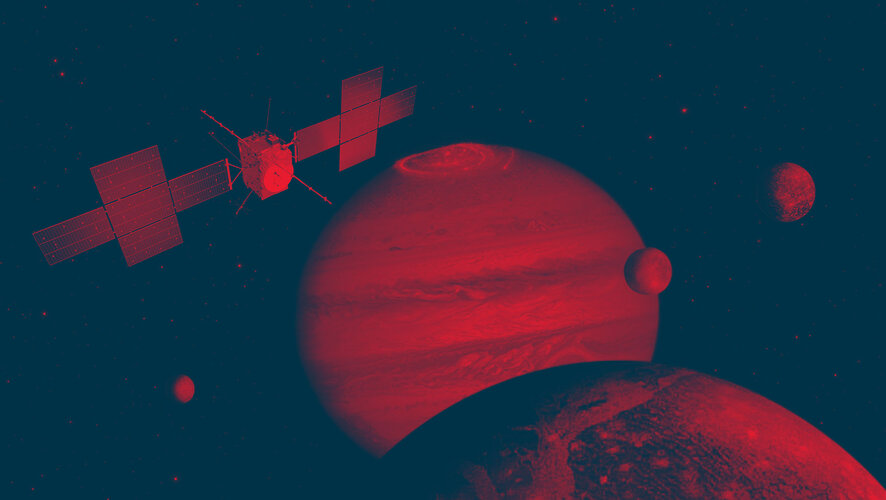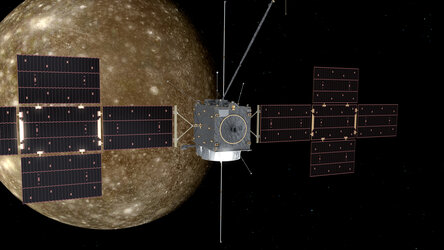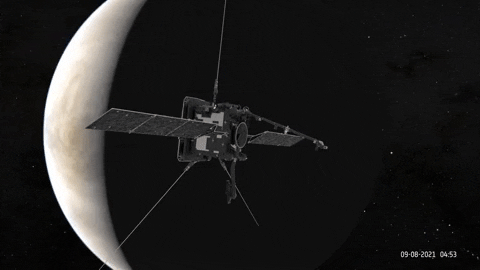Preparing for Juice’s daring double flyby
Next month, ESA’s Jupiter Icy Moons Explorer (Juice) will carry out the first combined lunar-Earth flyby. Preparations are under way at ESA mission control for this highly precise manoeuvre, which will harness the gravitational forces of the Moon and Earth in quick succession to line Juice up for the next stage of its journey to Jupiter.
Squeezing the most out of Juice’s return to Earth
Juice is Europe’s first mission to the Jupiter system. To reach its distant target, the spacecraft will carry out a series of manoeuvres known as gravity assists, flybys, swingbys or slingshots.
These manoeuvres change a spacecraft’s speed and trajectory using the gravity of a large object such as a planet or a moon. They conserve fuel and allow the spacecraft to be packed with as many scientific instruments as possible for the exploration of distant worlds.
Juice’s first gravity assist is particularly complex as it is actually two flybys back-to-back. The lunar-Earth flyby will see Juice pass just 750 km from the Moon’s surface at 23:15 CEST on 19 August and 6840 km from Earth’s surface almost exactly 24 hours later at 23:56 CEST on 20 August.

Using the gravity of the Moon to slightly bend Juice’s trajectory first will improve the effectiveness of the much larger gravity assist at Earth. However, the dual flyby requires extraordinarily precise navigation and timing, as even minor deviations could send Juice in the wrong direction.
“For a typical gravity assist, spacecraft operations have to be highly precise,” says Angela Dietz, Juice Spacecraft Operations Engineer. “For a double flyby, they must be pinpoint.”
Mission control ready for action
Teams from all across ESA’s ESOC operations centre have been called to action for Juice’s lunar-Earth flyby.
The Juice team are currently performing a series of trajectory correction manoeuvres to fine-tune the spacecraft’s path as it approaches the Earth-Moon system and ensure it arrives at exactly the correct angle and speed.

During the critical phase, the deep space antennas in ESA’s Estrack network will provide a near-constant communication link with Juice.
The continuous supply of real-time telemetry data will enable the flight control and flight dynamics teams to closely monitor Juice’s position, speed and trajectory, and rapidly respond to any anomalies or deviations.
During the Earth flyby, Juice will pass within the altitude of satellites in geostationary and medium-Earth orbits. ESA’s Space Debris Office will scan Juice’s trajectory to ensure a safe passage free from other satellites or space debris.
After the lunar-Earth flyby, as Juice bids farewell to its home planet for the second time, the teams will evaluate its new trajectory and carry out any further minor correction manoeuvres as needed.
Preparing for a spaceflight first
“A lunar-Earth flyby has never been attempted before,” says Angela Dietz. “There are risks, but all of Juice’s onboard systems have been rigorously tested, and we are well prepared.”

“Due to the low altitudes, large velocity changes and strict navigation requirements involved, the flight control team needs to be ready to react at a moment’s notice.”
“This week, we are running a training campaign to develop and rehearse the recovery procedures that we will use to get the spacecraft back on track as quickly as possible if we encounter any anomalies.”

During the recent ‘dry run’ of the payload operations that will take place during the double flyby, the flight control team commanded Juice to operate its various cameras and scientific instruments exactly as it will do during the real flybys to ensure that all systems behave as expected.
Juice’s instruments are designed to study a planet and its moons, so the lunar-Earth flyby offers a rare opportunity to test and calibrate them on similar objects and prepare them for their scientific activities at Jupiter.
In more ways than one, the successful execution of the first lunar-Earth flyby will bring Juice one step closer to unveiling the mysteries of Jupiter and its icy moons.
Follow our Rocket Science blog and @ESA_Juice and @esaoperations on X for the latest updates on Juice’s lunar-Earth flyby.


Access the video














 Germany
Germany
 Austria
Austria
 Belgium
Belgium
 Denmark
Denmark
 Spain
Spain
 Estonia
Estonia
 Finland
Finland
 France
France
 Greece
Greece
 Hungary
Hungary
 Ireland
Ireland
 Italy
Italy
 Luxembourg
Luxembourg
 Norway
Norway
 The Netherlands
The Netherlands
 Poland
Poland
 Portugal
Portugal
 Czechia
Czechia
 Romania
Romania
 United Kingdom
United Kingdom
 Slovenia
Slovenia
 Sweden
Sweden
 Switzerland
Switzerland

































